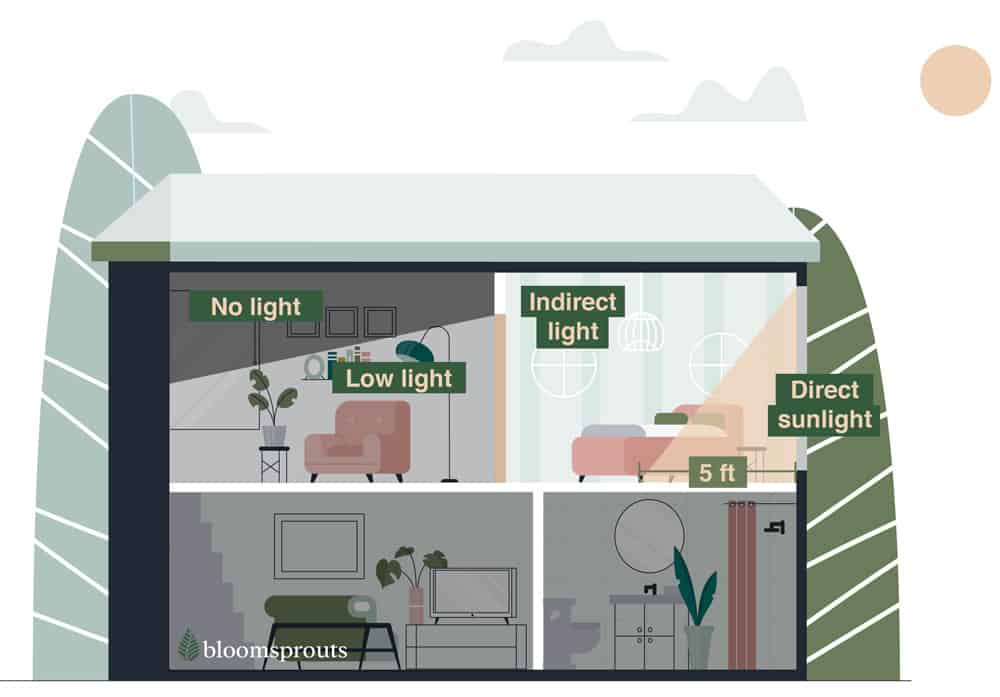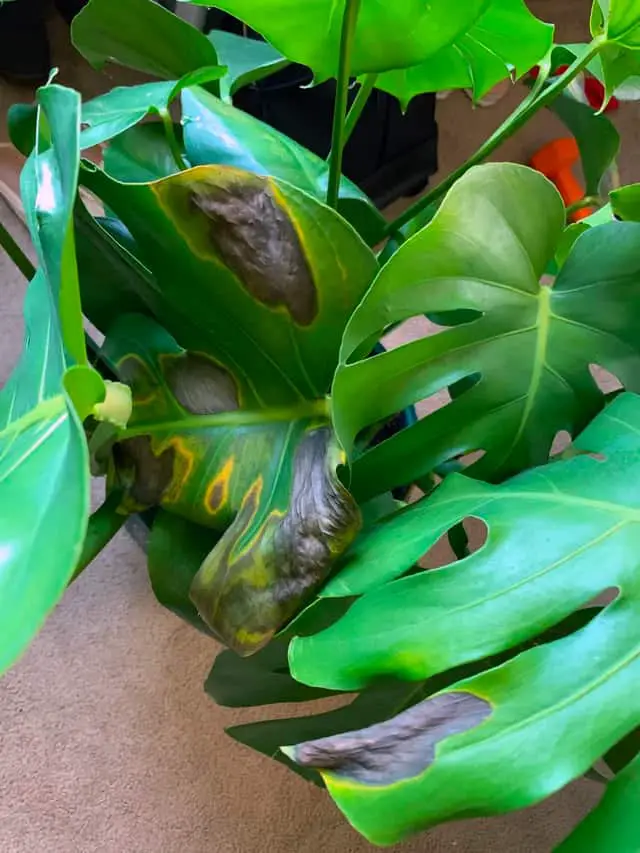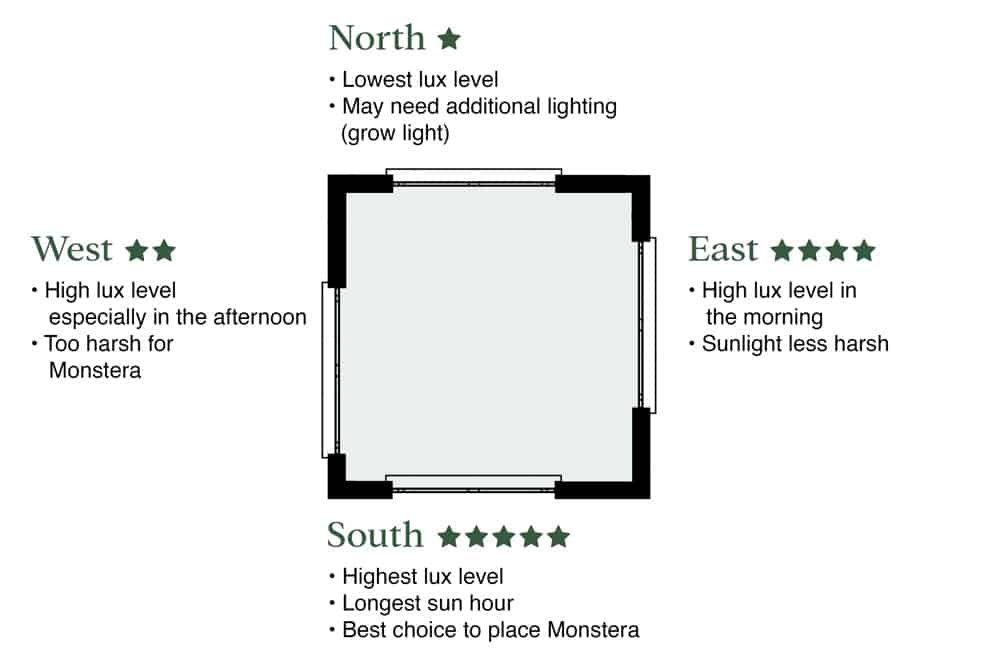
The best way to make sure your Monstera grows big, beautiful leaves with lots of fenestrations (those cool holes that are a sign of a mature Monstera) is for it to receive lots of light! But is there such a thing as too much light?
Monstera thrives best in bright, indirect light from the East or South facing window for at least 10 hours. Growth will slow down when placed in low light conditions. Beware, direct sunlight for an extended period will scorch the leaves.
This in-depth article will discuss how to measure your light level in your home and provide solutions when your light isn’t suitable for Monstera (either too low or too bright).
Let’s dive into it!
Also Read: Monstera Care 101 – How to Grow a Healthy and Happy Plant
Do Monstera Need Sunlight?
Monstera needs light for photosynthesis, a process where the chlorophyll on its leaves converts carbon dioxide in the air and water from the roots into oxygen and glucose component.
Glucose sugar is the primary source of food that help Monstera to grow.
On low light condition, Monstera can’t photosynthesis properly to produce the necessary glucose. That’s why its growth will slow down or even stop when placed in a room with low light level.
Needless to say, Monstera will wilt when it doesn’t receive any light at all.
Best Place to Keep Monstera
Whether your Monstera will live in your home or your office (or anywhere, really!), it must receive the right amount and kind of light.
The best place to keep the plant is in a room that has Southern– or Eastern-facing windows. These will provide the best bright, indirect light, which won’t burn the Monstera’s leaves.
Be careful with a direct bright light! Too much afternoon sun coming from a West-facing window directly on your Monstera’s leaves could give it a sunburn. It is best to keep your Monstera at least 5 feet away from a bright window.
Some people like to keep their Monsteras outside during warm weather. They can be acclimated to living outdoor during the summer, but they will need some shade, especially during the middle of the day.
The more light you give your Monstera, the bigger it will grow and the more beautiful fenestrations it will produce in its leaves.
Also Read: Reasons Your Monstera Has No Holes & Splits (Fenestration)
Monstera Growth to Different Lighting Conditions

Different light conditions will affect your Monstera in different ways. These reactions will tell you if your Monstera wants more or less light, or if it is happy where it is now!
| Light Condition | Monstera Growth Potential |
|---|---|
| Bright, indirect light | • fenestration (holes & splits) start to develop on the leaves • big and stronger foliage • new leaves sprouting (bushier look) |
| Bright, direct sunlight | • yellow or brown leaves • crisp leaves • leaves start curling • droopy leaves • burned leaves tips |
| Low light | • fenestration doesn’t develop • weaker foliage • stunted growth • leggy growth • may develop root rot if soil stay wet and soggy |
Bright, Indirect light
This light condition is perfect for your Monstera!
In bright, indirect light, your Monstera will grow to its fullest potential. Each new leaf will grow a little bit bigger than the last one.
As the Monstera matures, it will produce fenestrations on its larger leaves. These naturally-produced holes are the plant’s reaction to bright light, allowing sunlight to filter through to other plants growing lower in the jungle.
Bright, Direct Sunlight
Bright, direct sunlight is too harsh for Monsteras.
It will cause sunburn (just like people get) if your Monstera is left in the direct sun for too long. A sunburnt leaf has brown splotches where the sun got too hot, and sometimes it turns yellow on the edge of the brown splotches.

As long as the entire leaf isn’t burned, it is usually acceptable to leave on the plant, even though it isn’t very pretty. The burnt spot will never heal back into a healthy leaf, and the leaf will eventually turn yellow and fall off.
Monsteras can be acclimated to brighter light, to an extent, by slowly introducing them to more light every day. Too much at once will burn the leaves, but they can build up some tolerance to more sunlight over a few weeks. This is referred to as “hardening off.”
Low Light
Low light is not ideal for your Monstera. It will survive as long as there is some light, but low light will cause your Monstera to grow very slowly. Its leaves may be smaller and produce fewer fenestrations.
If your Monstera does not have enough light, it may start looking for more. In the wild, they do this by climbing trees with their air roots to get closer to the sun. But you don’t have any trees to climb in your house, do you? (I’m sure my boys would love it if we had one!)
So what does this “searching for light” look like for Monstera as a houseplant? Sometimes it will grow away from your window because it thinks it’s going towards a shady tree it can climb! Leaning away from your window is your Monstera telling you it wants more light.
Because lower light conditions slow the growth of your Monstera, it will need less water and fertilizer. Make sure to only water your plant when the top few inches of soil are dry.
Also Read: Monstera Water Requirements for Healthy and Bushy Leaves
How many hours of light do monstera need?
Monstera needs at least 10 hours of bright, indirect light each day. As you leave your Monstera longer in the light, it will grow bigger, bushier and lusher.
Afterall, Monstera uses light to convert carbon dioxide and water into oxygen and carbon-based compounds such as glucose, which helps it to grow.
In fact, when there is not much sunlight hour during the Winter, your Monstera will go dormant. You probably will observe your swiss cheese plant growth slows down.
You can always use grow lights to substitute the lack of sunlight hour in Winter.
Also Read: How to Care a Monstera in Winter (Complete Guide)
How can I measure my light?
There are a couple of different ways to measure your light. First, you could buy a lux meter to measure the exact Lux level (light intensity), or brightness, in different places you might want to keep your Monstera.
Monstera thrives at 1,000 LUX. While a room with lux level below 500 will cause the growth of your Monstera to slow down or (worse) stop!
Best facing window for Monstera
Alternatively, you can figure out what direction your windows are facing. This, plus observing how sunlight travels in your home, is usually enough to determine where to put plants with various light requirements.

South Facing Window
South-facing windows are going to have the brightest light (highest lux level) for people living in the Northern Hemisphere. These windows are best for plants that need the brightest light for the longest. Plants that require bright, indirect light, like Monsteras, do well a couple of feet away from south-facing windows to avoid the harshest sun rays.
East Facing Window
East-facing windows will also have bright light, but only during the morning. A Monstera could receive bright, indirect light when placed directly in front of an unobstructed east-facing window. The morning light from an east-facing window is not harsh and will not burn your Monstera.
West Facing Window
West-facing windows have bright, direct, hot, afternoon sun. This is great for a cactus, not so great for a Monstera.
North Facing Window
North-facing windows produce low light. Any plant will need to be right next to the window to get as much sun as possible, and they may still need some supplemental lighting.
What happens if Monstera has too much light?
While Monsteras like lots of light, there is sometimes too much of a good thing. You don’t want your Monstera to get too much sun, or else it might burn.
Signs of a burned Monstera
If your Monstera gets too much direct sun, its leaves will quickly produce brown, crispy splotches. After a while, the leaves will start turning yellow around these brown splotches.
Unfortunately, these brown spots are already dead and will never go back to being a perfect leaf.
Fear not, your Monstera is not dead. Move it away from the direct sunlight and wait, and it will soon begin to grow new leaves.
What to do with burnt Monstera leaves?
Unfortunately, individual burned Monstera leaves do not recover. But burned leaves are not a death sentence for your plant by any stretch of the imagination.
If your Monstera does end up with a burnt leaf (or two, or three…), just cut off the burned parts. If you can’t bring yourself to cut off any leaves just yet, that’s fine too. Your Monstera knows its leaves are damaged, and it will recover some of the energy put into them. The burned leaves will eventually turn yellow and fall off on their own.
Be cautious not to overwater your Monstera during this period. Plants with fewer leaves need less water in general, and Monsteras do not like soggy soil.
How to reduce bright light & glare
The easiest way to reduce harsh light would be to move your Monstera away from the offending light source. That could mean moving it a few feet away from a bright, sunny window.
If you don’t have the space to do any major redecorating, hanging a sheer curtain in a bright window will help prevent the sun’s rays from burning your prized Monstera.
Can a Monstera grow in Shade (Low Light)?
Technically, yes, your Monstera can grow in low light. It will not grow as fast or as large as it would in brighter light, but low light will not hurt a Monstera.
Signs Your Monstera Needs More Light
There are a few indicators that your Monstera wants more light:
Soil stays soggy for a while
The first thing you will probably notice is the soil staying wet for longer. With less sun, your Monstera is growing less, and it will therefore need less water. If your Monstera is in a location with low light, be careful not to overwater it.
Also read: How to create the most suitable soil mixture for Monstera
Monstera leaves stop growing and remain small
The next thing you will notice if your Monstera is growing in low light is that it will grow slowly. For some people, this may be good news, like if you live in a small apartment.
However, most people grow Monsteras because of how big they and their leaves can get—but they only grow to that size when they get enough light!
Monstera grow away from the window
As mentioned earlier in this article, Monsteras grow away from the light source to look for a tree to climb when they don’t get enough light. This is something to look out for if you think your Monstera isn’t getting enough light.
Monstera fails to develop holes and splits.
The final sign of not enough light for a Monstera is the amount of fenestrations their leaves have. Monsteras only grow their signature swiss-cheese-like holes in their leaves when they receive enough sunlight. Not enough sun means fewer fenestrations.
What to Do if My House Does not Have Enough Light?
Don’t despair if your home or office doesn’t have enough bright light. Your Monstera will survive. They are very hardy plants!
But, if you want to make sure they thrive, it would be good to get them a grow light. Think of it like giving your pretty plant a present.
There are lots of different ways you could go about setting up a grow light for your Monstera. You could go all-out with industrial-looking bulbs that release red and blue light for optimal growth.
Here is the light I am using for my houseplants in Winter when there is not much light hour. Reasons why I love it are because its dimmable to adjust with the requirement of my plants and it has timing function to automatically turn on and off.
